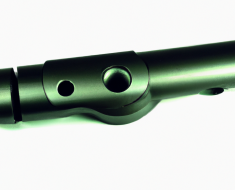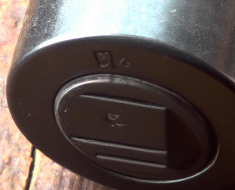“Unlock the potential of your AR-15 with the perfect bolt release.”
Material Options for Bolt Releases
When it comes to customizing your AR-15, one of the often-overlooked components is the bolt release. This small but crucial part plays a significant role in the functioning of your rifle, so it’s essential to choose the right one for your needs. Bolt releases come in a variety of materials, each with its own set of benefits and drawbacks. In this article, we will explore the different material options available for bolt releases and help you make an informed decision.
One of the most common materials used for bolt releases is aluminum. Aluminum bolt releases are lightweight, durable, and corrosion-resistant, making them a popular choice among AR-15 owners. They are also relatively affordable compared to other materials, making them a budget-friendly option for those looking to upgrade their rifle without breaking the bank.
Another popular material for bolt releases is steel. Steel bolt releases are known for their strength and durability, making them ideal for heavy-duty use. They are less prone to wear and tear than aluminum bolt releases, making them a long-lasting option for those who put their rifles through rigorous use. However, steel bolt releases are heavier than their aluminum counterparts, which may be a consideration for some users.
For those looking for a balance between strength and weight, titanium bolt releases are an excellent choice. Titanium is known for its exceptional strength-to-weight ratio, making it an ideal material for high-performance applications. Titanium bolt releases are lightweight, durable, and corrosion-resistant, making them a versatile option for AR-15 owners looking for a premium upgrade.
In addition to traditional metal materials, there are also polymer bolt releases available on the market. Polymer bolt releases are lightweight and affordable, making them a popular choice among budget-conscious shooters. While polymer may not be as durable as metal materials, it is still a reliable option for casual shooters or those looking to save on weight.
When choosing the right material for your bolt release, it’s essential to consider your specific needs and preferences. If you prioritize weight savings and affordability, aluminum or polymer may be the best options for you. If you require maximum durability and strength, steel or titanium bolt releases may be more suitable.
Ultimately, the best material for your bolt release will depend on your individual preferences and how you plan to use your AR-15. Whether you’re looking for a budget-friendly option or a high-performance upgrade, there is a material out there that will meet your needs. By carefully considering the pros and cons of each material type, you can make an informed decision and choose the right bolt release for your AR-15.
Compatibility with Different AR-15 Models
When it comes to choosing the right bolt release for your AR-15, there are a few key factors to consider. One of the most important considerations is compatibility with different AR-15 models. Not all bolt releases are created equal, and some may not work with certain AR-15s. Understanding which bolt release will work best with your specific model is essential to ensuring smooth and reliable operation.
The first step in determining compatibility is to identify the make and model of your AR-15. Different manufacturers may use slightly different specifications for their rifles, so it’s important to choose a bolt release that is designed to work with your specific firearm. Some bolt releases are universal and will work with a wide range of AR-15s, while others are designed for specific models or brands.
If you’re unsure about which bolt release is compatible with your AR-15, it’s always a good idea to consult the manufacturer’s website or contact their customer support team for guidance. They will be able to provide you with specific information about which bolt releases are compatible with your rifle, as well as any potential compatibility issues to watch out for.
Another important consideration when choosing a bolt release for your AR-15 is whether or not it will work with any aftermarket parts or accessories you may have installed on your rifle. Some bolt releases may not function properly if other components have been modified or replaced, so it’s important to ensure that all of your rifle’s parts are compatible with each other.
It’s also worth considering whether or not you plan to upgrade or modify your AR-15 in the future. If you think you may want to make changes to your rifle down the line, it’s a good idea to choose a bolt release that will be compatible with any potential upgrades you have in mind. This can help save you time and money in the long run by ensuring that you won’t have to replace your bolt release if you decide to make changes to your rifle.
In addition to compatibility with different AR-15 models, it’s also important to consider the quality and reliability of the bolt release you choose. Look for a bolt release made from high-quality materials that will withstand regular use and provide consistent performance. Reading reviews from other AR-15 owners can also help you determine which bolt releases are known for their durability and reliability.
Ultimately, choosing the right bolt release for your AR-15 comes down to understanding compatibility with different models and brands, as well as considering any potential upgrades or modifications you may want to make in the future. By taking the time to research and select the best bolt release for your specific rifle, you can ensure smooth and reliable operation every time you use your AR-15.
Ambidextrous vs. Non-Ambidextrous Bolt Releases
If you own an AR-15, you know how important it is to have the right accessories to enhance its performance. One such accessory that can make a big difference in how smoothly your rifle operates is the bolt release. The bolt release is a small but crucial component of your AR-15 that allows you to quickly and easily release the bolt after reloading.
When it comes to choosing a bolt release for your AR-15, one of the key decisions you’ll need to make is whether to go with an ambidextrous or non-ambidextrous option. Each type has its own set of advantages and disadvantages, so it’s important to understand what each has to offer before making your decision.
Ambidextrous bolt releases are designed to be easily operated by both right-handed and left-handed shooters. This can be a major advantage for those who shoot with their non-dominant hand, as it allows for faster and more efficient reloads. Additionally, ambidextrous bolt releases can be more comfortable to use for shooters with smaller hands or those who prefer a different grip on their rifle.
On the other hand, non-ambidextrous bolt releases are designed specifically for right-handed shooters. While this may seem like a disadvantage for left-handed shooters, many right-handed shooters find that non-ambidextrous bolt releases offer a more ergonomic and intuitive design. Additionally, non-ambidextrous bolt releases are often simpler in design and may be less prone to malfunction than their ambidextrous counterparts.
When choosing between an ambidextrous and non-ambidextrous bolt release for your AR-15, it’s important to consider your shooting style and preferences. If you frequently switch between shooting with your dominant and non-dominant hand, an ambidextrous bolt release may be the best option for you. However, if you primarily shoot with your dominant hand and prefer a simpler design, a non-ambidextrous bolt release may be more suitable.
Regardless of whether you choose an ambidextrous or non-ambidextrous bolt release for your AR-15, there are a few key factors to consider when making your decision. First and foremost, you’ll want to ensure that the bolt release is compatible with your specific model of AR-15. Some bolt releases are designed specifically for certain models or configurations of the AR-15, so be sure to do your research before making a purchase.
Additionally, you’ll want to consider the material and construction of the bolt release. Look for options made from high-quality materials such as aluminum or steel, as these will be more durable and long-lasting than cheaper alternatives. You’ll also want to consider the size and shape of the bolt release, as some designs may be more comfortable and easy to use than others.
In conclusion, choosing the right bolt release for your AR-15 is an important decision that can have a big impact on how smoothly your rifle operates. Whether you opt for an ambidextrous or non-ambidextrous design, be sure to consider factors such as compatibility, material, and ergonomics before making your purchase. With the right bolt release in place, you’ll enjoy faster reloads and improved performance from your AR-15.
Extended vs. Standard Bolt Releases
When it comes to customizing your AR-15, one of the key components that often gets overlooked is the bolt release. The bolt release is a critical part of your rifle that allows you to quickly and efficiently reload your weapon. There are two main types of bolt releases to choose from: extended and standard. Each type has its own set of benefits and drawbacks, so it’s important to understand the differences between them before making a decision.
Extended bolt releases are designed to provide a larger surface area for you to press down on when releasing the bolt. This can make it easier and faster to reload your rifle, especially in high-pressure situations where every second counts. Extended bolt releases are also popular among competitive shooters who need to shave off as much time as possible when reloading their weapon.
On the other hand, standard bolt releases are the traditional style that comes standard on most AR-15 rifles. While they may not offer the same level of convenience as extended bolt releases, standard bolt releases are still perfectly functional and reliable. Some shooters prefer the simplicity and familiarity of a standard bolt release, as they may find extended releases to be unnecessary or even cumbersome.
When deciding between an extended or standard bolt release for your AR-15, it ultimately comes down to personal preference and shooting style. If you prioritize speed and efficiency in your reloads, an extended bolt release may be the way to go. However, if you prefer a more traditional approach or simply don’t see the need for an extended release, a standard bolt release will serve you just fine.
Another factor to consider when choosing a bolt release is the size of your hands. Extended bolt releases may be more comfortable for shooters with larger hands, as they provide a larger surface area to press down on. Conversely, shooters with smaller hands may find standard bolt releases to be more ergonomic and easier to manipulate.
Ultimately, the best way to determine which type of bolt release is right for you is to try out both options and see which one feels more comfortable and natural. Many gun stores and shooting ranges offer rental rifles with different types of bolt releases, allowing you to test them out before making a purchase.
In conclusion, choosing the right bolt release for your AR-15 is an important decision that can have a significant impact on your shooting experience. Whether you opt for an extended or standard bolt release will depend on your personal preferences, shooting style, and hand size. By taking the time to weigh the pros and cons of each type of bolt release and trying out different options before making a decision, you can ensure that you choose the best option for your needs.
Installation and Maintenance Tips for Bolt Releases
When it comes to upgrading or customizing your AR-15, one component that often gets overlooked is the bolt release. The bolt release plays a crucial role in the functionality of your rifle, allowing you to easily and efficiently release the bolt after reloading. Choosing the right bolt release for your AR-15 can greatly improve your shooting experience and overall performance. In this article, we will discuss some key factors to consider when selecting a bolt release for your AR-15.
One of the first things to consider when choosing a bolt release is compatibility with your specific AR-15 model. Not all bolt releases are universal, so it is important to ensure that the one you choose is designed to work with your particular rifle. Take note of the make and model of your AR-15 and do some research to find bolt releases that are compatible with your firearm.
Another important factor to consider is the material of the bolt release. Bolt releases are typically made from either aluminum or steel, with each material offering its own set of advantages. Aluminum bolt releases are lightweight and corrosion-resistant, making them a popular choice among shooters who value weight savings and durability. Steel bolt releases, on the other hand, are heavier but offer superior strength and longevity. Consider your shooting preferences and needs when deciding which material is best for you.
In addition to compatibility and material, it is also important to consider the design and features of the bolt release. Some bolt releases feature extended or oversized buttons for easier access and manipulation, while others have textured surfaces for improved grip. Think about how you use your AR-15 and what features would enhance your shooting experience. If you frequently shoot in competitive or high-stress environments, an extended or oversized button may be beneficial. However, if you prioritize a sleek and minimalist design, a standard-sized button with a smooth surface may be more suitable.
When shopping for a bolt release, be sure to read reviews from other shooters who have used the product. This can provide valuable insights into the performance and reliability of the bolt release in real-world scenarios. Look for reviews that mention ease of installation, durability, and overall satisfaction with the product. Additionally, consider reaching out to fellow shooters or gunsmiths for recommendations on bolt releases that they have had success with.
Once you have chosen a bolt release for your AR-15, it is important to properly install and maintain it to ensure optimal performance. Follow the manufacturer’s instructions carefully when installing the bolt release, taking care to tighten all screws securely and test the functionality before heading to the range. Regularly clean and lubricate the bolt release to prevent dirt and debris from affecting its operation.
In conclusion, choosing the right bolt release for your AR-15 is an important decision that can greatly impact your shooting experience. Consider factors such as compatibility, material, design, and features when selecting a bolt release for your rifle. Read reviews from other shooters and seek recommendations from experts in the field. Once you have chosen a bolt release, install it properly and maintain it regularly to ensure reliable performance. By taking the time to research and select the best bolt release for your AR-15, you can enhance your shooting capabilities and enjoy greater accuracy and efficiency on the range.








